|

|
An Area 51 in Russia? Some
people think so and their suspicions are shared by the
US Congress. Testimony was taken on Congressional
suspicions of Russian complex in Yamantau Mountain,
circa 1997, and can be checked with the Congressional
Record for that session |
What's Going On in The Yamantau Mountain
Complex?
from
MondoVista Website
A Huge Anthill?
Starting in the Brezhnev period, Russia
has been pursuing construction of a massive underground facility
at Yamantau Mountain and the city of Mezhgorye (formerly the
settlements of Beloretsk-15 and Beloretsk-16).
Russia's 1997 federal budget lists the project as a closed territory
containing installations of the Ministry of Defense.
On April 16, 1996, the New York Times reported on a mysterious
military base being constructed in Russia:
"In a secret project reminiscent of
the chilliest days of the Cold War, Russia is building a mammoth
underground military complex in the Ural Mountains, Western
officials and Russian witnesses say.
"Hidden inside Yamantau mountain in the Beloretsk area of the
southern Urals, the project involved the creation of a huge
complex, served by a railroad, a highway, and thousands of
workers."
The complex, being built inside Yamantau
mountain by tens of thousands of workers, covers an area the size of
the Washington area inside the Beltway.
There are reportedly provisions for living inside the man-made
caves. There is an underground warehouse for food and clothing, a
shelter for the Russian national leadership in case of nuclear war,
and rumors that the Yamantau Mountain project was associated with
the so-called 'Dead Hand' nuclear retaliatory command and control
system for strategic missiles.
Some U.S. analysts believe the secret underground complex beneath Yamantau Mountain betrays a lingering belief among top Russian
leaders that they must continue to prepare to fight and win a
nuclear war. Russians say they still fear the U.S.
Priors on the Record
It is now known that the Soviet Union used secret underground bases
in Eastern Europe to conceal nuclear missiles at the end of the Cold
War, as an integral part of its nuclear war-fighting strategy. In
all, some 73 SS-23 missiles, packing a nuclear punch 365 times the
bomb that detonated over Hiroshima, were hidden by the Soviets in
violation of the INF Treaty, which went into force in June 1988.
If war had broken out those missiles would have given the Soviets an
overwhelming strategic advantage against the United States, allowing
them to decimate NATO forces in Europe in a surprise attack. The
last of these missiles will be destroyed by the government of
Slovakia, under a grant from the United States.
Today, Russia may be conducting nuclear deception on a far vaster
scale beneath Yamantau Mountain, where it has dug out a gigantic
underground military complex designed to withstand a sustained
nuclear assault. A U.S. intelligence source was quoted as saying
that the Yamantau complex is but one of some
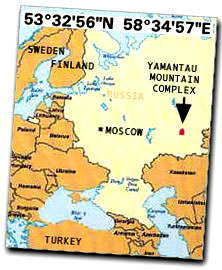 200
secret deep underground nuclear war-fighting sites in Russia, many
of which have been significantly upgraded over the past six years at
a cost of billions of dollars. 200
secret deep underground nuclear war-fighting sites in Russia, many
of which have been significantly upgraded over the past six years at
a cost of billions of dollars.
This declassified Defense Intelligence Agency map [right] shows the
relative location of the underground Yamantau Mountain complex.
Since the end of the Cold War in 1991, U.S. intelligence sources
believe the Russian government has pumped more than $6 billion into
Yamantau alone, to construct a sprawling underground complex that
spans some 400 square miles.
In 1998, in a rare public comment, then-Commander of the U.S.
Strategic Command (STRATCOM) Gen. Eugene Habinger, called
Yamantau
"a very large complex -- we estimate
that it has millions of square feet available for underground
facilities. We don't have a clue as to what they're doing
there."
It is believed to be large enough to
house 60,000 persons, with a special air filtration system designed
to withstand a nuclear, chemical or biological attack. Enough food
and water is believed to be stored at the site to sustain the entire
underground population for months on end.
"The only potential use for this
site is post-nuclear war..."
--- Rep. Roscoe Bartlett
Bartlett is one of the handful of
members of Congress who have closely followed the Yamantau project.
The Yamantau Mountain complex is located close to one of
Russia's remaining nuclear weapons labs, Chelyabinsk-70, giving rise
to speculation it could house either a nuclear warhead storage site,
a missile base, a secret nuclear weapons production center, a
directed energy laboratory or a buried command post. Whatever it is,
Yamantau was designed to survive a nuclear war.
In response to repeated U.S. inquiries, the Russian government has
provided no fewer than 12 separate and contradictory explanations
for the site, none of them believed to be credible.
A 1997 Congressional Research Service report said that the vast sums
invested to build the Yamantau Mountain complex "provide evidence of
excessive military modernization in Russia." Russia is pouring money
into this and other underground nuclear sites at the same time U.S.
taxpayers have provided billions of dollars in aid to Russia to help
dismantle nuclear warheads taken off line as a result of START I and
START II.
"Yamantau Mountain is the largest
nuclear-secure project in the world... They have very large
train tracks running in and out of it, with enormous rooms
carved inside the mountain. It has been built to resist a half
dozen direct nuclear hits, one after the other in a direct hole.
It's very disquieting that the Russians are doing this when they
don't have $200 million to build the service module on the
international space station and can't pay housing for their own
military people,"
---Rep. Bartlett.
The Russians have constructed two entire
cities over the site, known as Beloretsk 15 & 16, which are closed
to the public, each with 30,000 workers. No foreigner has ever set
foot near the site. A U.S. military attaché stationed in Moscow was
turned back when he attempted to visit the region a few years ago.
Neither the Central Intelligence Agency (CIA) nor the
Defense Intelligence
Agency (DIA) will comment on what the Russians are doing at Yamantau
Mountain.
"There's not a lot we could say
without venturing into the classified realm," CIA spokesman
Mike
Mansfield said. "It's hard to discuss it with any specificity."
This U.S. satellite photograph of the
Yamantau Mountain [below] region was taken on Oct. 16, 1997. Clearly
recognizable signs of excavation can be seen at the areas marked
Yamantau Mountain and Mezhgorye. Two above-ground support cities,
each housing 30,000 workers, are located at Beloretsk and
Tirlyanskiy.

The very little that is known publicly
about the site comes from Soviet-era intelligence officers, who
defected to Great Britain and the United States. In public testimony
before a House Armed Services Subcommittee last October, KGB
defector Col. Oleg Gordievsky said the KGB had maintained a
separate, top-secret organization, known as Directorate 15, to build
and maintain a network of underground command bunkers for the Soviet
leadership -- including the vast site beneath Yamantau Mountain.
"And what is interesting was that
President Yeltsin and Russia's new democratic leaders are using
those facilities, and the same service is still running the same
facility, like it was 10, 15 years ago."
--- Col. Oleg Gordievsky
Yamantau Mountain is so secret that only
a handful of Russian government officials knows about it, says Rep.
Curt Weldon, R-Pa., who speaks Russian and travels frequently
to Russia, chairing a congressional working group that discusses
strategic issues with counterparts from the Russian Duma.
"I ask the Russians about it every
time I meet with them... We've never had a straight answer."
Weldon got interested in Yamantau
Mountain in 1995 when he saw a public report suggesting it was a
vast mining project.
"I went to Moscow and spoke with the
deputy interior minister who was in charge of mining," Weldon
says. "I asked him if there was any mining activity there. He
just shook his head and said he had never heard of it. So I
mentioned the other name the Russians use for it: Mezhgorye. He
said he hadn't heard of that either. Then he sent an aide out to
check. Twenty minutes later, the aide came back, visibly shaken.
He said they couldn't say anything about it."
Weldon also met with Andrei Kokoshkin,
a former deputy defense minister, in charge of President Yeltsin's
National Security Council.
"Kokoshkin called it a public works
project, and said there was nothing to worry about, since the
Defense Ministry had no involvement in it. So I brought out a
copy of the Defense Ministry's budget -- it's only a few pages
long -- and showed him the line item for Mezhgorye. He smiled
and said it must be for bridges, roads and schools. When I then
asked if I could see it, he said that could only be arranged
through Yeltsin. The site was controlled directly by the
president."
Weldon then tried sending a 3-page
letter to Yeltsin in Russian.
"I told him all the things I was
trying to do to foster better U.S.-Russia understanding, but
said that I couldn't help if they couldn't clear up something as
important as this. He never replied."
Where's the Money Coming From?
The cause for concern is that the US is currently sending hundreds
of millions of dollars to Russia, supposedly to help that country
dismantle old nuclear weapons. Meanwhile, the Russian parliament has
been complaining that it cannot pay $250 million in back wages owed
to its workers at the same time that it is spending money to comply
with new strategic arms reduction treaties.
Aviation Week and Space Technology reported that,
"It seems the nearly $30 billion a
year spent on intelligence hasn't answered the question of what
the Russians are up to at Yamantau Mountain in the Urals. The
huge underground complex being built there has been the object
of U.S. interest since 1992. 'We don't know exactly what it is,'
says Ashton Carter, the Pentagon's international security mogul.
The facility is not operational, and the Russians have offered
'nonspecific reassurances' that it poses no threat to the U.S."
The following is an excerpt from an
interview between Chris Ruddy and Col. Stanislav Lunev,
a Russian military intelligence officer who defected in 1992. Col.
Stanislav Lunev is the highest-ranking military intelligence officer
ever to have defected from Russia.
You ask about Yamantau Mountain. Well, this is a huge underground
city, which could be used in time when many Russian cities are
destroyed, but the military and political elite will survive and
live until our planet will try to restore itself.
U.S. law states that the Administration must certify to Congress
that any money sent to Russia is used to disarm its nuclear weapons.
However, is that the case? If the Russian parliament is complaining
of a shortage of funds for nuclear disarmament, then how can Russia
afford to build the Yamantau complex?
Could American funds be subsidizing a Russian weapons factory? A
"doomsday" shelter? Or possibly something even more sinister? We'd
like to hear YOUR opinion. Write to
yamantau@viewzone.com.
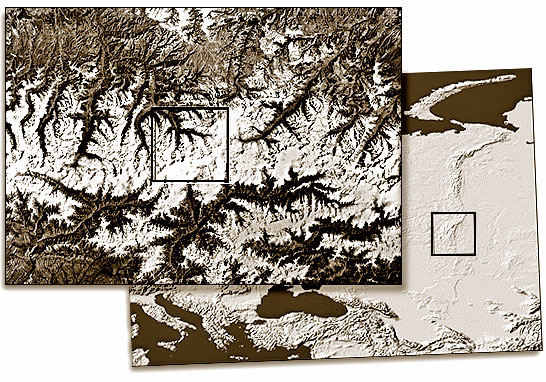
The Ural Mountains, which are
also called the Stone Belt, extend for 2500 km from the hot Kazakh
steppes to the frozen coast of the Arctic Ocean. Geographers divide
the Urals into five regions: South, Middle, North, Subarctic and
Arctic Urals. The widest part of the Urals is called the South
Urals, and comprises dozens of parallel ridges, bounded in the north
and in the south by the valleys of Ufalei River and Ural River
respectively.
Steppe and forest-steppe landscapes are
typical of the foothills in this part of the Urals. Higher in the
mountains, the hillsides are covered with mixed forests and the
highest peaks, like islands, emerge among the green ocean of forest.
The highest mountains of the South Urals - Yamantau (1640 m) and
Bolshoi Ieremele (1582 m) - are located in the western row of
ridges.
Yamantau - Beloretsk-15 -
Beloretsk-16 - Alkino-2
?
from
GlobalSecurity Website
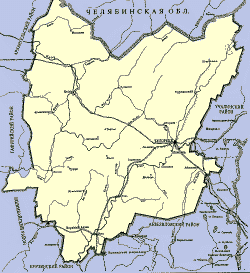
-
Beloretsk PPL 53°58'00"N
- 58°24'00"E
-
Yamantau Gora MT
54°15'19"N - 58°06'11"E
-
Al'kino PPL 55°05'00"N -
58°04'00"E
Starting in the Brezhnev period, Russia
has been pursuing construction of a massive underground facility at
Yamantau Mountain and the city of Mezhgorye (formerly the
settlements of Beloretsk-15 and Beloretsk-16). The complex,
reportedly being built by tens of thousands of workers, is said to
cover an area The reinforced underground bunkers take up 400 square
miles, the size of the Washington area inside the Beltway.
The exact location of this large facility is uncertain, and given
its reported size it may span as much as an entire degree of
latitude and longitude. It is apparently located near the the
Zlatoust-36/Yuryuzan nuclear weapons production plant and the
Yuryuzan national-level nuclear weapons storage facility.
-
The Yaman-Tau Gory [mountains] range
is centered at 52°25'N - 56°45'E, while the peak of Yamantau
Gora [mountain] is at 54°15'19"N - 58°06'11"E.
-
The town of Beloretsk is located at
53°58'N - 58°24'E, though NIMA does not include a listing for
Mezhgorye.
-
This facility may be synonymous with
"Alkino-2" since the town of Al'kino is nearby at 55°05'N -
58°04'E.
On April 16, 1996, the New York Times
reported on a mysterious military base being constructed in Russia:
"In a secret project reminiscent of
the chilliest days of the Cold War, Russia is building a mammoth
underground military complex in the Ural Mountains, Western
officials and Russian witnesses say. Hidden inside Yamantau
mountain in the Beloretsk area of the southern Urals, the
project involved the creation of a huge complex, served by a
railroad, a highway, and thousands of workers."
The New York Times quoted Russian
officials describing the underground compound variously as a mining
site, a repository for Russian treasures, a food storage area, and a
bunker for Russia's leaders in case of nuclear war. "The (Russian)
Defense Ministry declined to say whether Parliament has been
informed about the details of the project, like its purpose and
cost, saying only that it receives necessary military information,"
according to the New York Times.
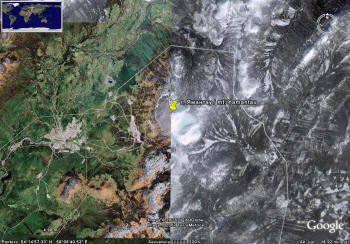 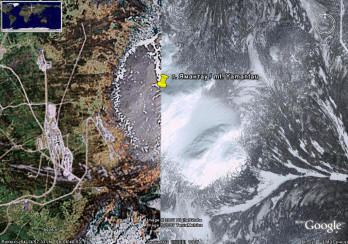
Satellite photographs of Yamantau Mountain show continued digging at
the "deep underground complex" and new construction at each of the
site's above-ground support areas. Judging from satellite photos and
other intelligence, US officials are fairly confident that the
Russians are building an underground command bunker and
communications installation. But,
"... the Russians are not very
interested in having us go in there," a senior American official
said in Washington.
"It is being built on a huge scale
and involves a major investment of resources. The investments
are being made at a time when the Russians are complaining they
do not have the resources to do things pertaining to arms
control."
Aviation Week and Space Technology
reported that,
"The huge underground complex being
built there has been the object of U.S. interest since 1992. 'We
don't know exactly what it is,' says Ashton Carter, the
Pentagon's international security mogul. The facility is not
operational, and the Russians have offered 'nonspecific
reassurances' that it poses no threat to the U.S."
Russia's 1997 federal budget lists the
project as a closed territory containing installations of the
Ministry of Defense.
Leonid Akimovich Tsirkunov, commandant of Beloretsk-15 and
Beloretsk-16, stated in 1991 and 1992 that the purpose of the
construction there was to build a mining and ore-processing complex,
but later claimed that it was an underground warehouse for food and
clothing. And then Commander-in-Chief of the Strategic Rocket Forces
General Igor Sergeyev denied that the facility was associated with
nuclear forces.
M.Z. Shakiorov, a former
communist official in the region, alleged in 1992 that the Yamantau
Mountain facility was to become a shelter for the Russian national
leadership in case of nuclear war. Sources of the Segodnya newspaper
in 1996 claimed that the Yamantau Mountain project was associated
with the so-called 'Dead Hand' nuclear retaliatory command and
control system for strategic missiles.
Beloretsk is a center of Beloretsk region of Bashkortostan. It is
situated on the cross of Belaya River and Magnitogorsk-Beloretsk-Karloman
rail-road. It is 264 km. far from Ufa and 105 km. far from
Magnitogorsk. The population was 73600 of people in 1995 ( 19900 in
1926, 59300 in 1959, 72400 in 1989). One of the oldest mining and
metallurgical centers of South Ural appeared because of construction
of the metallurgical works. Before The First World War narrow-gauge
Zaprudovka-Beloretsk line was built. In 1923 the village Beloretskiy
Zavod grew into town, in 1926 it was connected with Tukan and in
1927 with Inzer by narrow-gauge line.
Wood and ore was transported from these
towns to the plant. Including the plant to the field of activity of
Uralo-Kuzneckiy group of enterprise was the reason of its
reconstruction and its transferring to a coking coal. Town
development became quicker after constructing the rail-road to Ufa
(1997). The main city industry is the metallurgical works. Other
plants in Beloretsk produce tools for building, springs for
tractors, nails, etc. There are also woodworking industry, meat and
dairy factories, plants producing bricks and ferro-concret items.
The Republic of Bashkortostan is located in the Southern part of the
Urals along the line of Europe and Asia. Its area is 143,600 sq. m.
As of January 1, 1995 the population of Bashkortostan was 4.097
million people. The capital is Ufa is with a population of 1.1
million residents. The republic has 54 administrative areas ("rayons")
and 21 cities.
Other large cities include Sterlitamak
(256,000 inhabitants), Salavat (155,000), Nefetekamsk (123,000),
Oktyabrsky (108,000). Representatives of 70 nations and ethnicities
live in the Republic of Bashkortostan, including Russians (39.3
percent), Tatars (28.4 percent) and Bashkirs (21.9 percent). The
urban population constitutes 65 percent of the total.
 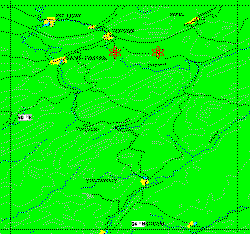
SOURCES and METHODS
-
SENSE OF CONGRESS ON NEED FOR RUSSIAN
OPENNESS ON THE YAMANTAU MOUNTAIN PROJECT (House of
Representatives - June 19, 1997)
-
Moscow builds bunkers against nuclear
attack By Bill Gertz THE WASHINGTON TIMES 01 April
1997 pg 1
-
General Denies Nuclear Construction in
Urals , INTERFAX, 4/18/1996 -- The commander of
Russia's missile forces has denied allegations that an
underground anti-nuclear bunker is under construction outside
the city of Beloretsk in Bashkortostan near the Yamantau
Mountain.
-
What Is That There Under the Mountain?
, A. Urtsev and V. Yeldashev, BELORETSKIY RABOCHIY, 3/24/1996 --
Interview with Bashkortostan People's Deputy Leonid Akimovich
Tsirkunov outlining the purpose of the facilities that are being
built in the cities of Beloretsk-15 and Beloretsk-16.
-
Inzer Isn't All That Bad, L.
Tsirkunov, BELORETSKIY RABOCHIY, 9/2/1993 -- Further on
Pollution at Beloretsk-15
-
Returning to What Was Printed: Don't Drink
Water From the Inzer!, G. Sitdikova, BELORETSKIY
RABOCHIY, 8/7/1993 -- Biological Clean-Up Work At Beloretsk-15
-
Natural Landmarks of Beloretsk Rayon,
A. Dmitriyev, BELORETSKIY RABOCHIY, 7/22/1993 -- Geographical
features of a polluted region.
-
One of the Secrets of Yaman- Tau,
A. Vorobyev, BELORETSKIY RABOCHIY, 7/13/1991 -- Essay on a 1975
reconnaissance plane crash in the Bashkortostan region in
Russia.
-
Contradiction of Yamantau's Status as
Preserve and Facility Questioned , 7/2/1991 --
Expresses support for protecting the polluted Bashkortostan
region.
-
U.S. Officials Puzzled By Big Hole
Russians Are Digging By Terry Atlas, Chicago Tribune April 17,
1996
-
Mount Weather's Russian Twin By
Patricia Neill Matrix Editor
-
MT. YAMANTAU -- FROM THE FOLKS WHO BROUGHT
YOU THE COLD WAR DECISION BRIEF No. 96-D 37 - 16
April 1996
-
WHY IS RUSSIA PREPARING FOR WAR?
-
Nuclear Conflict in the Urals?
-
Moscow Builds Bunkers against
Nuclear Attack, The Washington Times, 1/Apr/97
|

 200
secret deep underground nuclear war-fighting sites in Russia, many
of which have been significantly upgraded over the past six years at
a cost of billions of dollars.
200
secret deep underground nuclear war-fighting sites in Russia, many
of which have been significantly upgraded over the past six years at
a cost of billions of dollars. 





